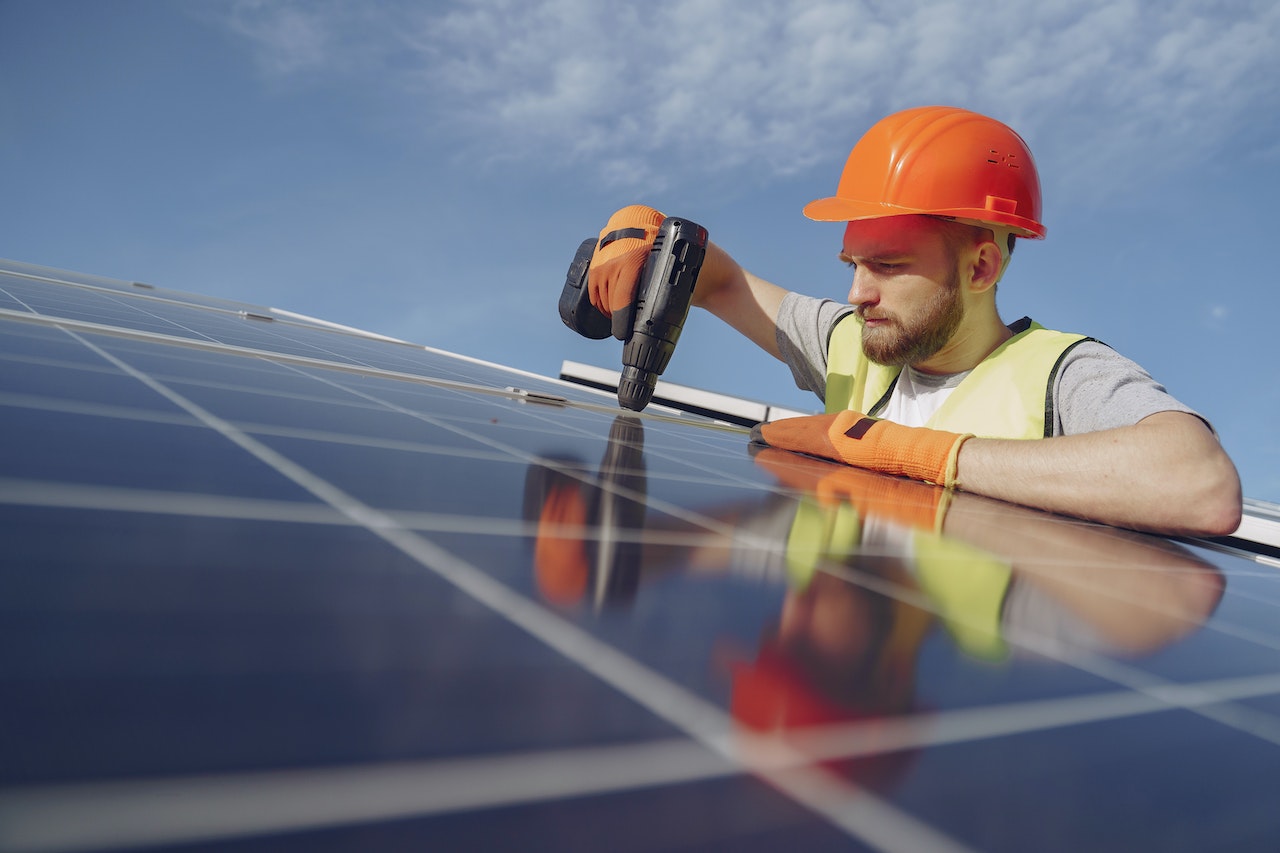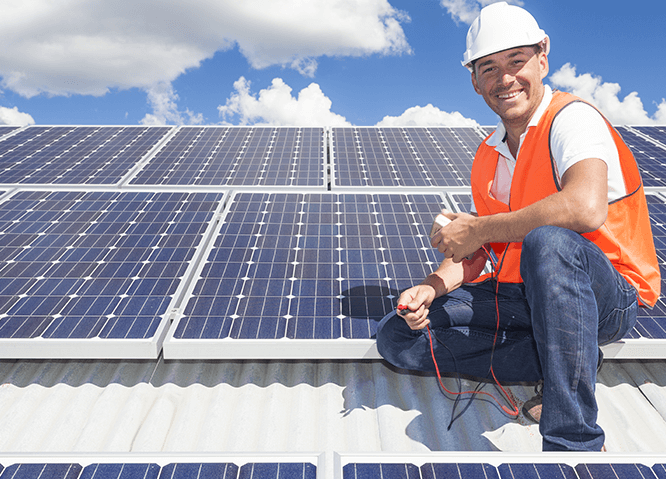To become a solar installer, you should complete training in solar panel installation and obtain certification. Additionally, gaining on-the-job experience is crucial for success in this field.
Solar installation courses are available through trade schools or community colleges, and some companies offer apprenticeships or on-the-job training. With the increasing demand for renewable energy, becoming a solar installer can provide a rewarding and sustainable career path. As a solar installer, you will play a pivotal role in the growing industry of renewable energy.
These professionals are responsible for assembling, installing, and maintaining solar panel systems on residential, commercial, and industrial properties. In addition to being environmentally conscious, a career as a solar installer offers competitive wages and potentially significant job growth in the future. If you are interested in a career that combines technical skills with a commitment to sustainability, becoming a solar installer could be an ideal fit for you.
Requirements and Training
If you are passionate about renewable energy and keen to enter the growing field of solar installation, there are a few requirements and training you need to consider. Education and certification as well as technical training are key aspects that will set you on the path to becoming a solar installer.
Education and Certification
While a formal education is not always a requirement to become a solar installer, having a high school diploma or equivalent is beneficial. It provides a solid foundation in areas such as math, science, and technology which are essential in the field of solar installation. Additionally, certifications can give you an edge over other candidates and validate your expertise in solar PV (photovoltaic) systems.
| Relevant Certifications for Solar Installers | Benefits of Certification |
|---|---|
|
|
Technical Training
Technical training plays a crucial role in equipping you with the skills and knowledge necessary to become a competent solar installer. This training typically covers topics such as solar energy fundamentals, electrical systems, design principles, installation best practices, and safety protocols.
Several organizations and institutions offer technical training programs specifically designed for solar installers. These programs may include classroom instruction, hands-on practical exercises, and field experience to ensure a well-rounded learning experience. Some renowned organizations offering technical training include:
- Solar Energy International (SEI)
- NABCEP
- Community colleges and vocational schools
- Solar installation companies
By enrolling in these training programs, you will gain the necessary expertise to confidently work with solar PV systems, troubleshoot issues, and make informed decisions during the installation process. This combination of education, certification, and technical training will position you as a qualified solar installer ready to contribute to the growth of renewable energy.

Credit: www.energywarden.com
Understanding Solar Technology
Solar Panel Types
Solar panels come in various types like monocrystalline, polycrystalline, and thin-film, each with unique characteristics.
Inverter and Battery Systems
Effective solar installations require inverters to convert DC power from panels to AC power for household use, along with battery systems for energy storage.
Also Read: How to Become a Notary Public in Arizona
Site Assessment and Design
Becoming a solar installer requires expertise in site assessment and design, crucial for efficient solar energy systems installation.
Analyzing Roofs and Shading
Analyzing roofs for suitability involves checking for orientation, tilt, and structural integrity. Shading analysis ensures optimal sunlight exposure.
Creating System Layouts
Developing system layouts involves determining panel placement and wiring configuration. Efficient designs maximize energy production.

Credit: www.greenlancer.com
Permitting and Regulations
When it comes to becoming a solar installer, understanding the permitting and regulations surrounding solar installations is crucial. Adhering to local codes and obtaining necessary permits ensures you comply with legal requirements and guarantees the safety and long-term success of your solar projects.
Understanding Local Codes
Before embarking on any solar installation project, it’s important to familiarize yourself with the local codes and regulations governing solar installations in your area. Local codes vary from one jurisdiction to another, and they dictate various aspects of the installation process, including design, equipment, and safety requirements.
Ensure you thoroughly research and understand these codes, as they often outline specific compliance measures, such as minimum system size, setbacks, roof load restrictions, and electrical regulations. Ignoring or overlooking any of these guidelines can lead to costly mistakes or even legal complications.
Obtaining Necessary Permits
Once you are familiar with the local codes, the next step is to obtain the necessary permits for your solar installation. Permitting requirements can vary greatly depending on your location, and it’s essential to follow proper procedures to ensure your project’s legality and compliance.
Contact your local building department or permitting office to determine the specific permits required for your solar installation. Common permits may include building permits, electrical permits, and fire permits. It’s important to note that some jurisdictions may also require engineering or structural evaluations for larger-scale projects.
When applying for permits, provide all required documentation and specifications, including system design plans, electrical diagrams, and any manufacturer certifications. Be prepared to pay the associated fees and wait for the approval process, which can range from a few days to several weeks.
Remember that obtaining the necessary permits is not only a legal requirement but also important for insurance purposes and potential future home sales. Non-compliance can lead to fines, project delays, and damage to your professional reputation.
Installation Process
Welcome to the installation process section of our guide on How to Become a Solar Installer. The installation process is a critical aspect of solar panel installation, ensuring that the panels are accurately mounted and connected to provide optimal energy efficiency.
Mounting Solar Panels
Mounting solar panels is the initial step in the installation process. When mounting the panels, it’s crucial to ensure a secure and stable placement to withstand various weather conditions, such as wind and rain. The mounting system used should be durable and designed to support the weight of the panels.
Wiring and Connection
After the panels are securely mounted, the wiring and connection phase begins. This involves carefully connecting the panels to the electrical system, ensuring that the wiring is properly insulated and weatherproof to prevent any electrical hazards. The connections must be tested to verify that the panels are generating power efficiently.

Credit: everbluetraining.com
Testing and Maintenance
Testing and maintenance are crucial aspects of a solar installer’s role, ensuring that solar systems operate efficiently and reliably over their lifespan. Implementing robust procedures for system performance evaluation and routine maintenance helps to optimize the performance and longevity of solar installations.
System Performance Evaluation
Conducting regular system performance evaluations is essential to identify any issues and ensure optimal energy production. This evaluation involves assessing the overall performance of the solar system, including panels, inverters, and associated equipment. Performance metrics such as energy output, voltage, and current are measured and analyzed to identify any deviations from expected performance levels. By conducting thorough system performance evaluations, solar installers can detect potential problems early and take appropriate corrective actions.
Routine Maintenance Procedures
Establishing and adhering to routine maintenance procedures is vital for upholding the long-term functionality of solar installations. Routine maintenance tasks such as cleaning panels, inspecting wiring connections, and checking for shading obstructions help prevent performance degradation and minimize the risk of system downtime. Additionally, verifying the structural integrity and weatherproofing of the system components is essential to ensure the overall safety and reliability of the solar installation.
Safety Measures
To excel as a solar installer, prioritize safety measures, like wearing protective gear and following installation protocols. Proper training and attention to detail are essential for a successful career in the solar industry. Mastering these safety practices ensures a safe work environment and quality installations.
Risk Assessment
To ensure the safety of both yourself and others, conducting a thorough risk assessment before starting any solar installation project is crucial. This assessment helps identify potential hazards and plan for their prevention or mitigation. Before beginning any work, take the following steps:- Inspect the site and surrounding area for any existing dangers, such as unstable structures or overhead power lines.
- Review any available site plans to understand the layout and identify any specific risks.
- Consider the weather conditions and how they may impact safety, such as strong winds or extreme temperatures.
- Identify potential electrical hazards, such as live wires or faulty equipment.
- Assess the potential risk of falls from heights and plan for appropriate fall protection measures.
Emergency Procedures
Even with the best safety measures in place, accidents can still happen. That’s why it’s important to have clear and effective emergency procedures in place to minimize the impact and respond swiftly. Follow these guidelines:- Ensure all team members are aware of the nearest emergency exits and evacuation routes.
- Have a designated first aid kit readily available and ensure everyone knows its location.
- Train your team on basic first aid procedures, such as CPR and treating minor injuries.
- Establish a communication plan to quickly alert emergency services if needed.
- Regularly test and maintain fire suppression equipment, such as fire extinguishers, to avoid any unforeseen mishaps.
- Review and update emergency procedures regularly to account for any changes or improvements.
Career Opportunities and Growth
Exploring the field of solar installation can lead to a rewarding and promising career. In the realm of Career Opportunities and Growth, this industry offers a wide range of possibilities for individuals seeking a career in renewable energy.
Job Outlook
The job outlook for solar installers is exceptionally bright with significant growth projected in the coming years. As the world shifts towards clean energy solutions, the demand for solar installations continues to increase.
Advancement Potential
The advancement potential in the solar installation field is substantial. With the continuous technological advancements, solar installers have the opportunity to enhance their skills and specialize in niche areas, opening doors to higher-paying positions.
Conclusion
Becoming a solar installer is an exciting and fulfilling career choice in the renewable energy industry. By following these steps and gaining the necessary knowledge, skills, and experience, you can embark on a successful journey as a solar installer. Remember to continuously educate yourself on the latest advancements in solar technology and stay updated with industry trends.
With dedication, passion, and perseverance, you can make a positive impact on the environment while enjoying a rewarding career. Start your journey today towards becoming a skilled and sought-after solar installer.
